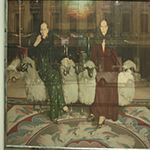Euroacademia Conferences
 Europe Inside-Out: Europe and Europeanness Exposed to Plural Observers (9th Edition) April 24 - 25, 2020
Europe Inside-Out: Europe and Europeanness Exposed to Plural Observers (9th Edition) April 24 - 25, 2020 Identities and Identifications: Politicized Uses of Collective Identities (9th Edition) June 12 - 13, 2020
Identities and Identifications: Politicized Uses of Collective Identities (9th Edition) June 12 - 13, 2020 8th Forum of Critical Studies: Asking Big Questions Again January 24 - 25, 2020
8th Forum of Critical Studies: Asking Big Questions Again January 24 - 25, 2020 Re-Inventing Eastern Europe (7th Edition) December 13 - 14, 2019
Re-Inventing Eastern Europe (7th Edition) December 13 - 14, 2019 The European Union and the Politicization of Europe (8th Edition) October 25 - 26, 2019
The European Union and the Politicization of Europe (8th Edition) October 25 - 26, 2019 Identities and Identifications: Politicized Uses of Collective Identities (8th Edition) June 28 - 29, 2019
Identities and Identifications: Politicized Uses of Collective Identities (8th Edition) June 28 - 29, 2019 The European Union and the Politicization of Europe (7th Edition) January 25 - 26, 2019
The European Union and the Politicization of Europe (7th Edition) January 25 - 26, 2019 7th Forum of Critical Studies: Asking Big Questions Again November 23 - 24, 2018
7th Forum of Critical Studies: Asking Big Questions Again November 23 - 24, 2018 Europe Inside-Out: Europe and Europeanness Exposed to Plural Observers (8th Edition) September 28 - 30, 2018
Europe Inside-Out: Europe and Europeanness Exposed to Plural Observers (8th Edition) September 28 - 30, 2018 Identities and Identifications: Politicized Uses of Collective Identities (7th Edition) June 14 - 15, 2018
Identities and Identifications: Politicized Uses of Collective Identities (7th Edition) June 14 - 15, 2018
Through Art to Good Diplomatic Relations: Exhibitions of Soviet Art in Germany, Italy and the US in the 1920s
-
-

-
Presentation speakers
- Marija Podzorova, University Paris 7 – Paris Diderot and University Paris 1 – Paris Sorbonne, France
Abstract:
In 1922 the Soviet Russia started to face the challenge of having its government legally recognized on an international level. Soviet authorities used different ways to create a diplomatic relationship with Western countries. One of these ways was the organization of exhibitions of artworks abroad. Specifically important in this context were exhibitions held in the US, Germany and Italy where only for the period of the 1920s were organized over fifty exhibitions directly or indirectly linked with fine arts (etchings, graphic art, paintings or sculpture). Modern art was not the only one presented, the visitors could also see ancient art (icons and religious handcraft) and folk art handcraft. Each type of art in these exhibitions matched specific and unique purposes. In this paper I focus only on a few samples : The first exhibition of “Russian art” in Berlin in 1922, the exhibition of Soviet art in Venice in 1924 and 1926, the first exhibition of “Russian art” in New-York in 1924 and the exhibition of Soviet-Russian art in the same city in 1929. All these exhibitions were organized by the authorities of the Soviet Union, but in several cases the Soviet Union was not directly linked to these exhibitions. For example, the exhibitions organized in the early 1920s were supported by non-governmental organizations like Workers’ International Relief or the Red Cross. For other exhibitions the Soviet government entrusted the organization to the VOKS and the Narkompros. The aim of this paper is to bring a light on the way how the multi-institutional organization of these exhibitions influenced the choice of artworks to be presented and artists to be employed and also how these choices influenced the creation of an image of the Soviet Union as a country of tolerance and open-mindedness in the artistic field in the 1920s.
-
Related Presentations


















